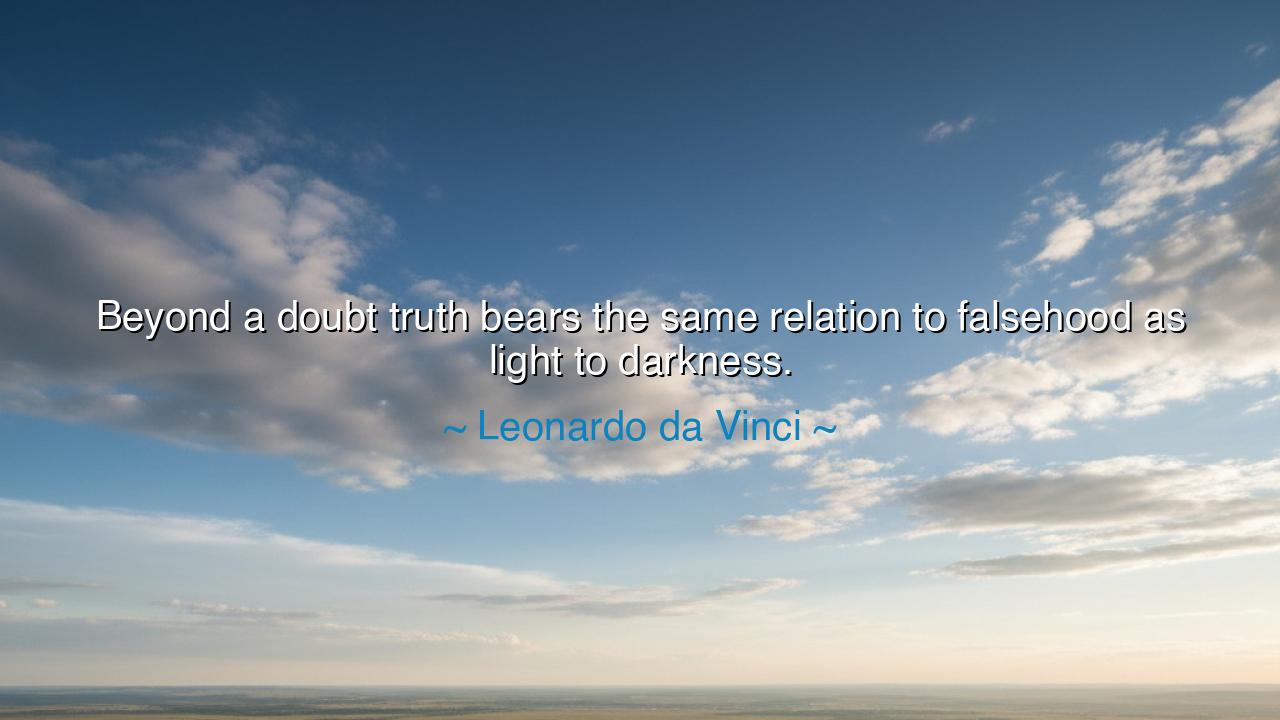
Beyond a doubt truth bears the same relation to falsehood as






Hear the radiant words of Leonardo da Vinci, painter, inventor, and seer of mysteries: “Beyond a doubt truth bears the same relation to falsehood as light to darkness.” This saying rises like the sun itself, declaring that truth is not merely better than falsehood, but its very opposite—its destroyer, its conqueror, its eternal adversary. Just as one flame can scatter the shadows of an entire cavern, so one word of truth can dispel the fog of a thousand lies.
The ancients knew this well. From the first pages of sacred writings, light is the symbol of creation, goodness, and order, while darkness is the cloak of chaos and deceit. When da Vinci speaks of truth as light, he places it in that eternal lineage: a force that reveals, clarifies, and awakens. And when he likens falsehood to darkness, he unmasks its essence: it hides, it confuses, it blinds. The two cannot coexist; wherever truth shines, falsehood flees.
Consider the life of Galileo, a man who followed da Vinci in seeking the hidden laws of the cosmos. He spoke the truth that the earth moves around the sun, yet the world of his time tried to bury him in darkness. They silenced his voice, confined him, and demanded he recant. But the light of his discovery could not be extinguished. Centuries later, his persecutors are remembered with shame, while his truth continues to shine across the world. Here is the proof of da Vinci’s words: darkness can cover light for a moment, but it cannot prevail against it.
So too in the life of Martin Luther King Jr. He stood against the falsehood of segregation and declared the truth of human equality. Many resisted him, cloaking themselves in hatred, fear, and prejudice. Yet when he spoke, his words were like fire in the night, igniting the conscience of a nation. Though assassins sought to silence him, his truth continues to shine brighter than the bullets that struck him down. His story shows us that light may suffer under darkness, but it always rises again.
Why is this so? Because truth and falsehood are not equal rivals. Darkness is not a thing in itself—it is only the absence of light. So too falsehood is not reality, but a distortion, a void where truth is missing. When light enters, darkness vanishes; when truth speaks, lies collapse. This is why da Vinci calls it “beyond a doubt”—for it is a law not only of nature but of the soul.
The lesson for us is this: do not fear the darkness of falsehood, for it has no substance of its own. Instead, kindle the flame of truth within you. Even a small act of honesty can scatter great shadows of deceit. Speak the truth in your home, in your work, in your dealings with others. Refuse to be part of the lies that bind society, whether in corruption, gossip, or hypocrisy. For each time you choose truth, you add to the light that no darkness can overcome.
Therefore, let this teaching be sealed upon your heart: truth is light, falsehood is darkness. The world will always hold both, but you must choose which to carry. Be as the torchbearer in the night—though your light may seem small, it will guide others, and together many lights will drive back the shadows. This was da Vinci’s vision: that those who live by truth walk in the brightness of eternity, while those who cling to falsehood fade into the obscurity of night.






THNguyen Thi Thu Huong
This quote by da Vinci really makes me reflect on the fundamental nature of truth. If truth is like light, then it illuminates, reveals, and exposes—while falsehood keeps us in the shadows. How do we ensure that we are not living in darkness, accepting lies without questioning them? Can we create a culture where truth shines brighter, or is it always going to be a struggle between light and darkness?
NNNhi Nguyen
Da Vinci’s quote is so thought-provoking because it reflects how absolute truth is compared to the uncertainty of falsehood. I find it interesting that truth is likened to light, which is so clear and undeniable, while falsehood is more like darkness, something that obscures and deceives. How often do we settle for the 'darkness' of falsehood because it’s easier or more comfortable, even when the truth is right in front of us?
TLTien Lam
I love how da Vinci uses light and darkness to explain truth and falsehood—it’s a simple but effective metaphor. It makes me ask, if truth is like light, why do we sometimes resist it or feel uncomfortable in its presence? Could it be that we’re afraid of what truth might reveal, just like we’re often hesitant to step into bright light after being in the dark?
SHNguyen sy hung
This quote by da Vinci paints such a clear and stark contrast between truth and falsehood. The idea that truth and falsehood are as inherently different as light and darkness makes me think—why do we often find it hard to see truth in situations clouded by lies? Can truth ever truly shine through when it’s surrounded by falsehood, or does it require active efforts to seek and reveal it?
NTNgoc Tu
Leonardo da Vinci’s comparison of truth to light and falsehood to darkness is so powerful. It suggests that truth is not just the opposite of falsehood, but its natural counterpart, like light is to darkness. I wonder—does this imply that truth has an inherent clarity and brilliance, while falsehood is something that obscures? How can we actively bring more 'light' into situations where we’re surrounded by confusion or deceit?